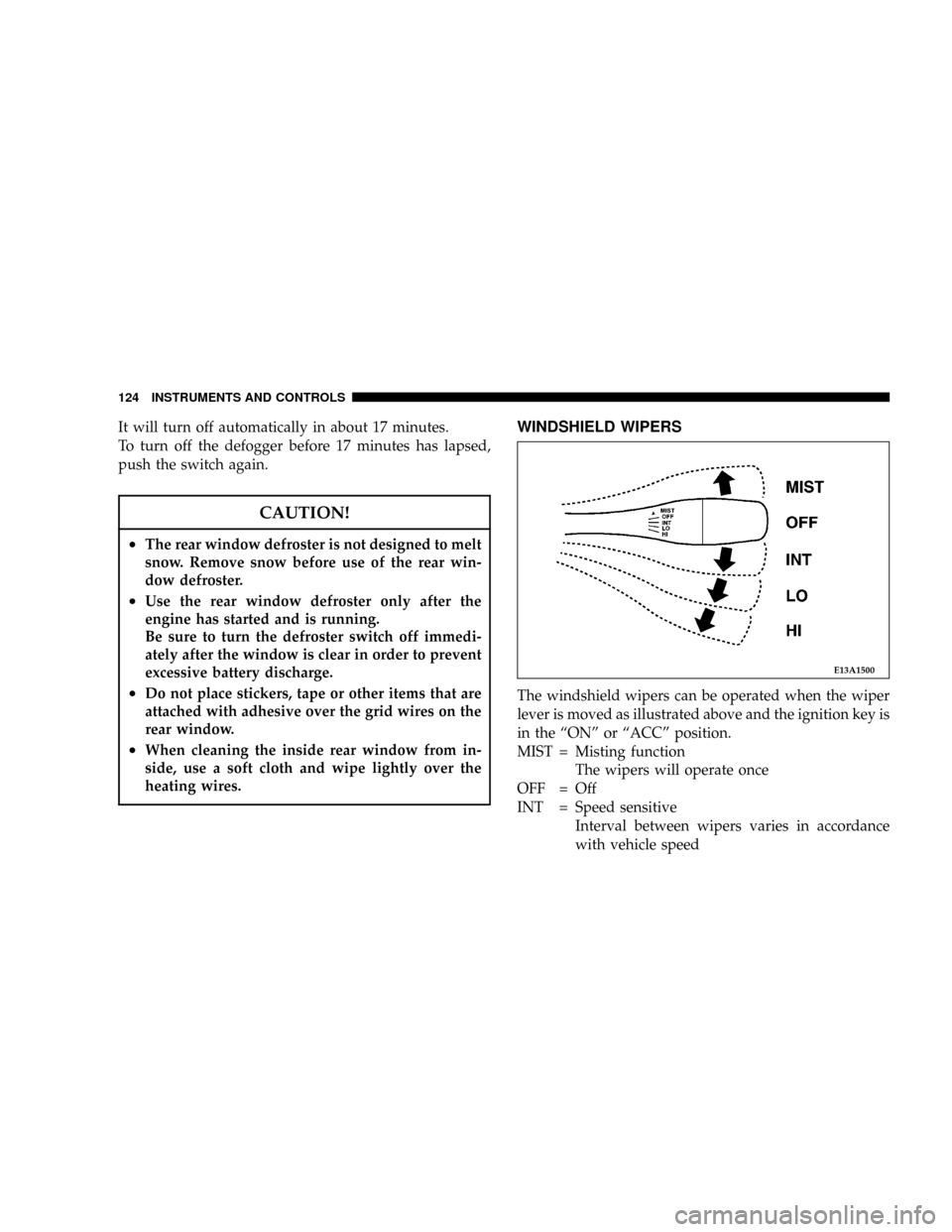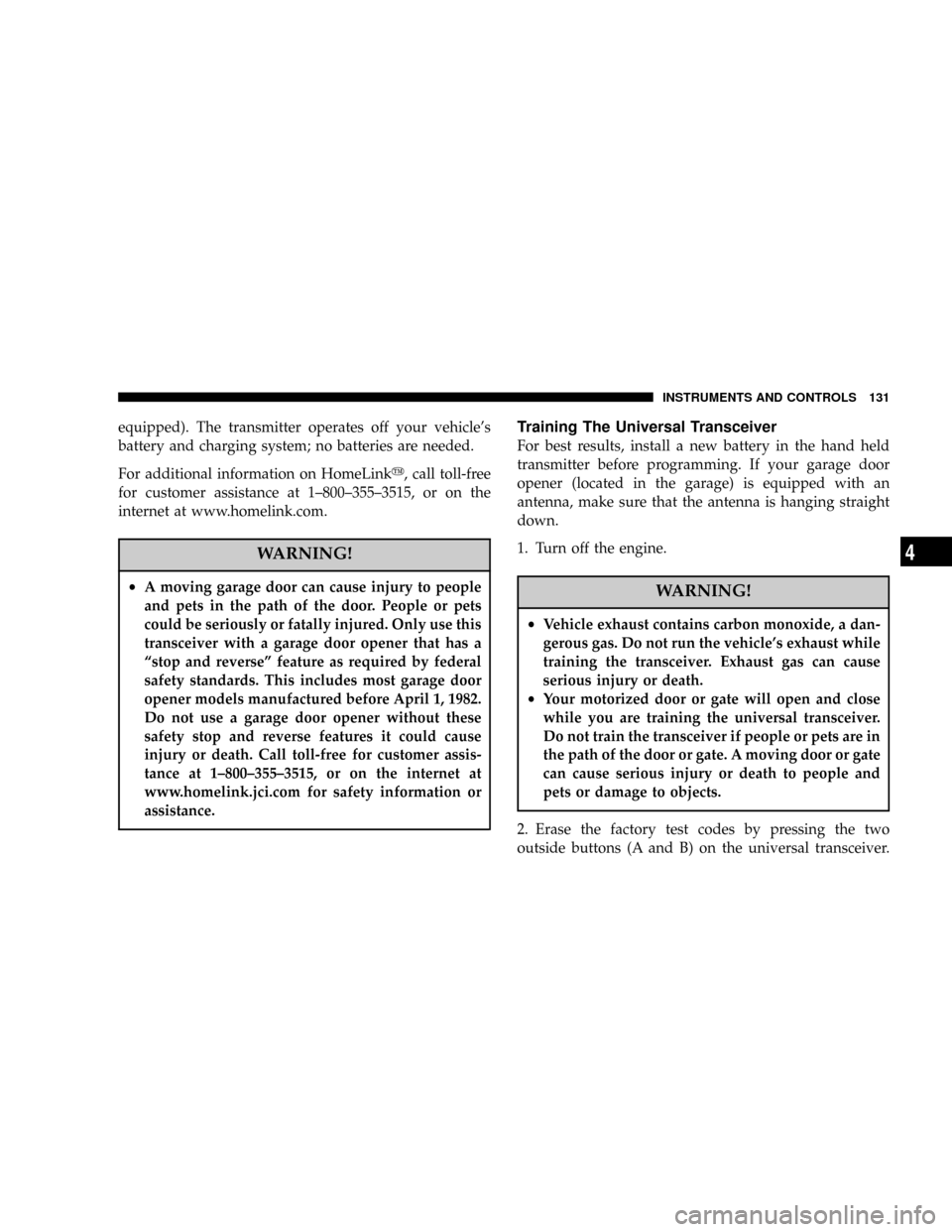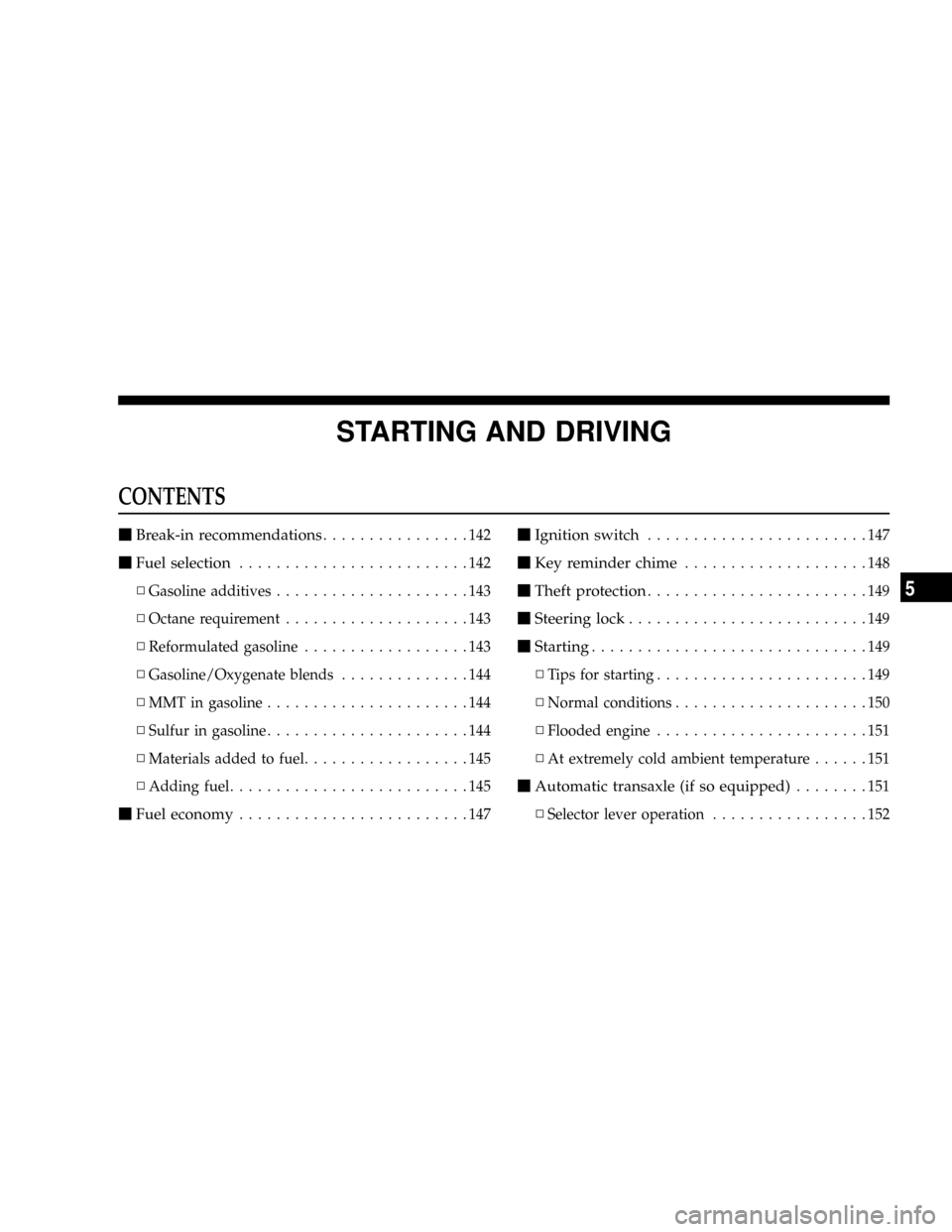Page 124 of 382

It will turn off automatically in about 17 minutes.
To turn off the defogger before 17 minutes has lapsed,
push the switch again.
CAUTION!
²The rear window defroster is not designed to melt
snow. Remove snow before use of the rear win-
dow defroster.
²Use the rear window defroster only after the
engine has started and is running.
Be sure to turn the defroster switch off immedi-
ately after the window is clear in order to prevent
excessive battery discharge.
²Do not place stickers, tape or other items that are
attached with adhesive over the grid wires on the
rear window.
²When cleaning the inside rear window from in-
side, use a soft cloth and wipe lightly over the
heating wires.
WINDSHIELD WIPERS
The windshield wipers can be operated when the wiper
lever is moved as illustrated above and the ignition key is
in the ªONº or ªACCº position.
MIST = Misting function
The wipers will operate once
OFF = Off
INT = Speed sensitive
Interval between wipers varies in accordance
with vehicle speed
E13A1500
124 INSTRUMENTS AND CONTROLS
Page 129 of 382
READING LIGHTS
1. Driver 's side
2. Passenger 's side
Push the right or left reading light switch (lens) to turn on
the light.
This light produces a spot beam for convenient use as a
map light at night.
Push the reading light switch again to turn the light off.
NOTE:
²If the reading lights are left on for prolonged periods of
time with the engine turned off, the battery will be
discharged (run down).G08C0070
E19A1280
1
2
INSTRUMENTS AND CONTROLS 129
4
Page 131 of 382

equipped). The transmitter operates off your vehicle's
battery and charging system; no batteries are needed.
For additional information on HomeLinky, call toll-free
for customer assistance at 1±800±355±3515, or on the
internet at www.homelink.com.
WARNING!
²A moving garage door can cause injury to people
and pets in the path of the door. People or pets
could be seriously or fatally injured. Only use this
transceiver with a garage door opener that has a
ªstop and reverseº feature as required by federal
safety standards. This includes most garage door
opener models manufactured before April 1, 1982.
Do not use a garage door opener without these
safety stop and reverse features it could cause
injury or death. Call toll-free for customer assis-
tance at 1±800±355±3515, or on the internet at
www.homelink.jci.com for safety information or
assistance.
Training The Universal Transceiver
For best results, install a new battery in the hand held
transmitter before programming. If your garage door
opener (located in the garage) is equipped with an
antenna, make sure that the antenna is hanging straight
down.
1. Turn off the engine.
WARNING!
²Vehicle exhaust contains carbon monoxide, a dan-
gerous gas. Do not run the vehicle's exhaust while
training the transceiver. Exhaust gas can cause
serious injury or death.
²Your motorized door or gate will open and close
while you are training the universal transceiver.
Do not train the transceiver if people or pets are in
the path of the door or gate. A moving door or gate
can cause serious injury or death to people and
pets or damage to objects.
2. Erase the factory test codes by pressing the two
outside buttons (A and B) on the universal transceiver.
INSTRUMENTS AND CONTROLS 131
4
Page 139 of 382

STARTING AND DRIVING
CONTENTS
mBreak-in recommendations................142
mFuel selection.........................142
NGasoline additives.....................143
NOctane requirement....................143
NReformulated gasoline..................143
NGasoline/Oxygenate blends..............144
NMMT in gasoline......................144
NSulfur in gasoline......................144
NMaterials added to fuel..................145
NAdding fuel..........................145
mFuel economy.........................147
mIgnition switch........................147
mKey reminder chime....................148
mTheft protection........................149
mSteering lock..........................149
mStarting..............................149
NTips for starting.......................149
NNormal conditions.....................150
NFlooded engine.......................151
NAt extremely cold ambient temperature......151
mAutomatic transaxle (if so equipped)........151
NSelector lever operation.................152
5
Page 142 of 382

BREAK-IN RECOMMENDATIONS
Advanced automobile manufacturing techniques permit
you to operate your new vehicle without experiencing a
long break-in period of low-speed driving.
However, you can add to the future performance and
economy of your vehicle by observing the following
precautions during the first 300 miles (500 km).
It is recommended that you drive your vehicle at mod-
erate speeds during the break-in period.
1. Avoid racing the engine.
2. Avoid harsh driving such as fast starts, sudden accel-
eration, prolonged high-speed driving and abrupt appli-
cation of the brakes. These operations not only have a
detrimental effect on the engine but also cause increased
fuel and oil consumption, which could result in malfunc-
tion of engine components. Be particularly careful to
avoid wide-open throttle acceleration in low gear.
3. Do not overload the vehicle. Observe the seating
capacity. (See ªWeightsº page 359)
4. Do not use this vehicle for trailer towing during the
break-in period.
FUEL SELECTION
Your vehicle is designed to use unleaded gasoline only. It
is equipped with a fuel filler tube especially designed to
accept only the smaller diameter unleaded gasoline dis-
pensing nozzle.
WARNING!
Gasoline is highly flammable and explosive. You can
be burned or seriously injured when handling it.
When refueling this vehicle, always turn the engine
off and keep flames, sparks, and smoking materials
away. Always handle fuel in well-ventilated outdoor
areas.
142 STARTING AND DRIVING
Page 143 of 382

CAUTION!
Using leaded gasoline in your vehicle will damage
the engine, catalytic converter, and the oxygen sen-
sors. Further, using leaded gasoline is illegal, and
will void warranty coverage of the engine, catalytic
converter, and oxygen sensors.
Gasoline additives
Many fuel suppliers add detergents to their gasoline to
minimize fuel injector fouling and to control intake valve
deposits. These detergent gasolines are highly recom-
mended for use in your vehicle. They help keep your
engine in tune and your emission control system working
properly.
Octane requirement
2.4 liter engine model
Your vehicle is designed to operate on unleaded gasoline
having a minimum octane rating of 87 [(MON+RON)/2],
or 91 RON.
3.0 liter engine model
Your vehicle is designed to operate on regular grade
unleaded gasoline having a minimum octane rating of 87
[(MON+RON)/2], or 91 RON. If optimum performance
is wanted, it is recommended to use premium grade
unleaded gasoline having an octane rating of 91
[(MON+RON)/2], or 95 RON.
MON: Motor Octane Number
RON: Research Octane Number
Reformulated Gasoline
Many areas of the country require the use of cleaner
burning fuel referred to as ªReformulated Gasolineº.
Reformulated gasolines contain oxygenates, and are spe-
cially blended to reduce vehicle emissions and improve
air quality.
The manufacturer supports the use of reformulated gaso-
lines. Properly blended reformulated gasolines will pro-
vide excellent performance and durability of engine and
fuel system components.
STARTING AND DRIVING 143
5
Page 145 of 382

states adopting California emission standards, your ve-
hicle will operate satisfactorily on fuels meeting Federal
specifications, but emission control system performance
may be adversely affected.
Gasoline sold outside of California is permitted to have
higher sulfur levels which may affect the performance of
the vehicle's catalytic converter. This may cause the
Check Engine Light to illuminate. The manufacturer
recommends that you try a different brand of unleaded
gasoline having lower sulfur to determine if the problem
is fuel related prior to returning your vehicle to an
authorized dealer for service.
CAUTION!
If the Malfunction Indicator Light (Service Engine
Soon) is flashing, immediate service is required. See
the On Board Diagnostics paragraph in the Mainte-
nance section of this manual.
Materials Added to Fuel
All gasoline sold in the United States is required to
contain effective detergent additives. Use of additional
detergents or other additives is not needed under normal
conditions and would result in additional cost. Therefore
you should not have to add anything to the fuel.
Adding Fuel
NOTE:
The fuel tank filler tube has a restricting door
about 2 inches (50 mm) down from the opening. If fuel is
poured from a portable container, the container should
have a flexible nozzle long enough to force open the
restricting door.
CAUTION!
To avoid fuel spillage and overfilling, do not ªtop
offº the fuel tank after filling.
NOTE:When the fuel nozzle ªclicksº or shuts off, the
fuel tank is full.
STARTING AND DRIVING 145
5
Page 146 of 382

NOTE:Tighten the gas cap until you hear a ªclickingº
sound. This is an indication that the gas cap is properly
tightened.
The Malfunction Indicator Light (ªSERVICE ENGINE
SOONº) will come on if the gas cap is not properly
secured. Make sure that the gas cap is tightened each
time the vehicle is refueled.
WARNING!
A fire may result if gasoline is pumped into a
portable container that is inside of a vehicle. You
could be burned. Always place gas containers on the
ground while filling.
Fuel Filler Cap (Gas Cap)
The gas cap is behind the fuel filler door, on the passen-
ger's side of the vehicle. If the gas cap is lost or damaged,
be sure the replacement cap is for use with this vehicle.
CAUTION!
Damage to the fuel system or emission control
system could result from using an improper fuel
tank filler tube cap (gas cap). A poorly fitting cap
could let impurities into the fuel system.
CAUTION!
A poorly fitting gas cap may cause the Malfunction
Indicator Light (ªSERVICE ENGINE SOONº) to
turn on.
WARNING!
²Never have any smoking materials lit in or near
the vehicle when the gas cap is removed or the
tank filled.
²Never add fuel to the vehicle when the engine is
running.
146 STARTING AND DRIVING